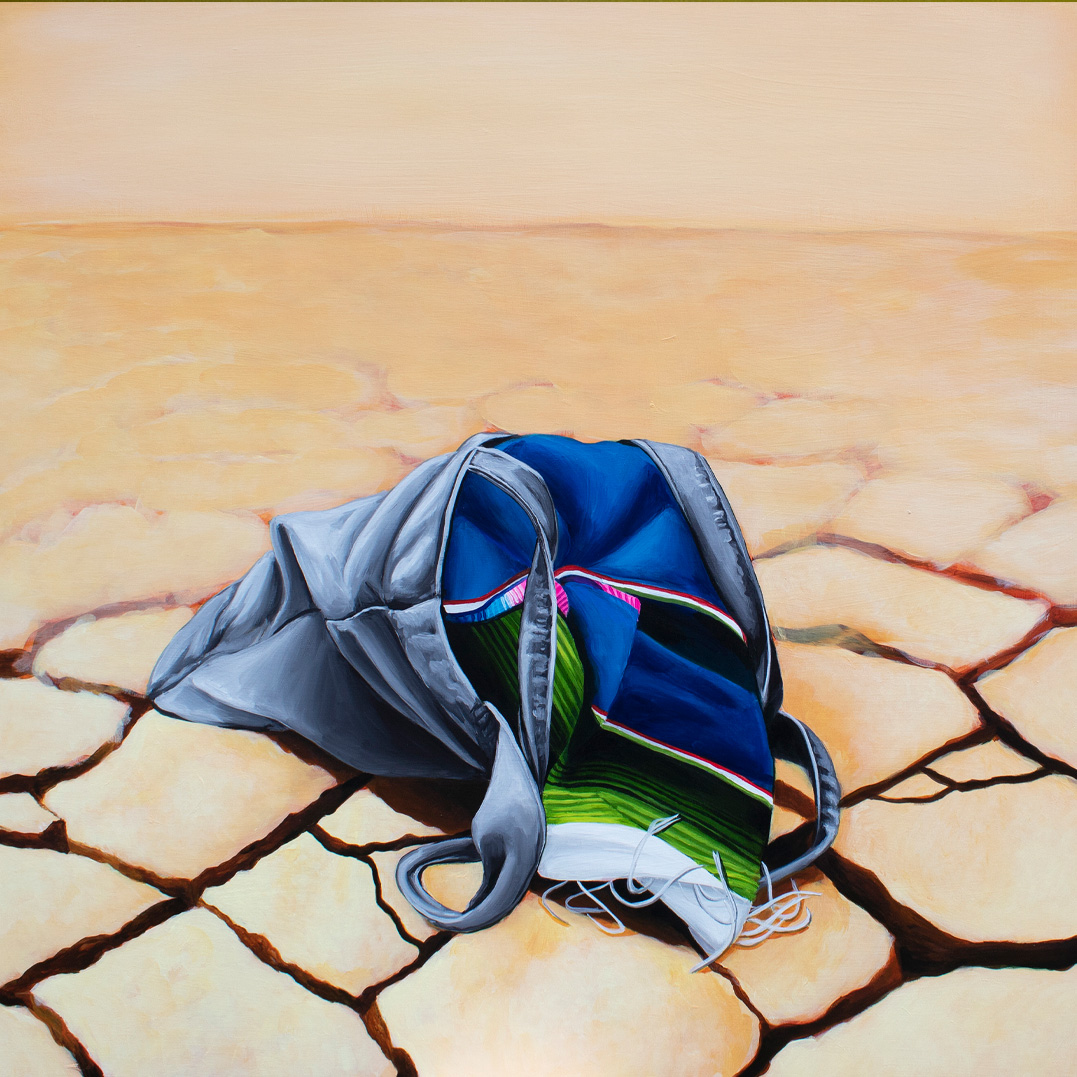ELIANA MIRANDA
Eliana Miranda is a visual artist and co-founder of Nuestra Artist Collective who currently lives in Dallas, TX. In 2010, she completed her BA from Hamilton College in Clinton, New York. She obtained her MA in 2012 and an MFA in 2015 from the University of Dallas. She’s been in numerous exhibitions including Latino Americans 500 Years of History at the Idaho State University, Contemporaneous Commentary: Voices in the Current Sociopolitical Atmosphere at the Wichita State University, Intersections at the Texas Woman’s University, and the AMOA Biennial 600: Justice• Equality• Race• Identity at the Amarillo Museum of Art. She was one of the selected artists for the virtual residency with the Mexic-Arte Museum in Austin, TX., and the 2022 Texas Vignette. Her work has been featured in publications such as The Dallas Observer, KERA, and D Magazine.
Miranda’s work is an exploration of current human migration issues. She investigates the environmental and socio/political impact of the displacement of people.
Artist Statement
My work investigates environmental intersectionality and the influence on the migration of people headed towards the U.S./ Mexico border from Mexico, Central America, and South America. The movement of people from marginalized communities are often affected by ecological disasters that stem from climate change. Severe weather events such as heat waves, flooding, and drought are some of the catalysts for these migrations. However, the influence of a changing climate is not only present in these regions, but it is also felt through the militarization of the U.S. Mexico Border. Heat, land, and water on which this border exists are used as a weapon to hurt immigrants and asylum seekers.
These migrations present a timeline of struggle. Rooted in the regions of Mexico, Central America, and South America, and continuing at the border, the struggle to survive the environmental elements are apparent. However, survival is multi-faceted and the social repercussions of being uprooted from an area known as a home are complex.
ELIANA MIRANDA
Eliana Miranda is a visual artist and co-founder of Nuestra Artist Collective who currently lives in Dallas, TX. In 2010, she completed her BA from Hamilton College in Clinton, New York. She obtained her MA in 2012 and an MFA in 2015 from the University of Dallas. She’s been in numerous exhibitions including Latino Americans 500 Years of History at the Idaho State University, Contemporaneous Commentary: Voices in the Current Sociopolitical Atmosphere at the Wichita State University, Intersections at the Texas Woman’s University, and the AMOA Biennial 600: Justice• Equality• Race• Identity at the Amarillo Museum of Art. She was one of the selected artists for the virtual residency with the Mexic-Arte Museum in Austin, TX., and the 2022 Texas Vignette. Her work has been featured in publications such as The Dallas Observer, KERA, and D Magazine.
Miranda’s work is an exploration of current human migration issues. She investigates the environmental and socio/political impact of the displacement of people.
Artist Statement
My work investigates environmental intersectionality and the influence on the migration of people headed towards the U.S./ Mexico border from Mexico, Central America, and South America. The movement of people from marginalized communities are often affected by ecological disasters that stem from climate change. Severe weather events such as heat waves, flooding, and drought are some of the catalysts for these migrations. However, the influence of a changing climate is not only present in these regions, but it is also felt through the militarization of the U.S. Mexico Border. Heat, land, and water on which this border exists are used as a weapon to hurt immigrants and asylum seekers.
These migrations present a timeline of struggle. Rooted in the regions of Mexico, Central America, and South America, and continuing at the border, the struggle to survive the environmental elements are apparent. However, survival is multi-faceted and the social repercussions of being uprooted from an area known as a home are complex.

ELIANA MIRANDA
Eliana Miranda is a visual artist and co-founder of Nuestra Artist Collective who currently lives in Dallas, TX. In 2010, she completed her BA from Hamilton College in Clinton, New York. She obtained her MA in 2012 and an MFA in 2015 from the University of Dallas. She’s been in numerous exhibitions including Latino Americans 500 Years of History at the Idaho State University, Contemporaneous Commentary: Voices in the Current Sociopolitical Atmosphere at the Wichita State University, Intersections at the Texas Woman’s University, and the AMOA Biennial 600: Justice• Equality• Race• Identity at the Amarillo Museum of Art. She was one of the selected artists for the virtual residency with the Mexic-Arte Museum in Austin, TX., and the 2022 Texas Vignette. Her work has been featured in publications such as The Dallas Observer, KERA, and D Magazine.
Miranda’s work is an exploration of current human migration issues. She investigates the environmental and socio/political impact of the displacement of people.
Artist Statement
My work investigates environmental intersectionality and the influence on the migration of people headed towards the U.S./ Mexico border from Mexico, Central America, and South America. The movement of people from marginalized communities are often affected by ecological disasters that stem from climate change. Severe weather events such as heat waves, flooding, and drought are some of the catalysts for these migrations. However, the influence of a changing climate is not only present in these regions, but it is also felt through the militarization of the U.S. Mexico Border. Heat, land, and water on which this border exists are used as a weapon to hurt immigrants and asylum seekers.
These migrations present a timeline of struggle. Rooted in the regions of Mexico, Central America, and South America, and continuing at the border, the struggle to survive the environmental elements are apparent. However, survival is multi-faceted and the social repercussions of being uprooted from an area known as a home are complex.
